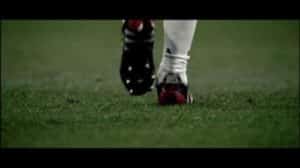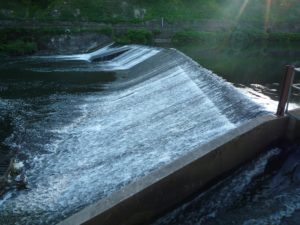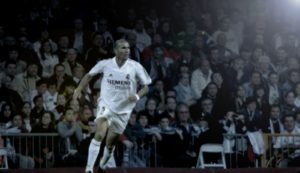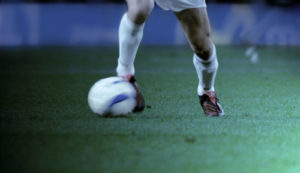In the year of 2008 I first read about the documentary Zidane: A 21st Century Portrait and immediately became interested. What called my attention was the idea of how a portrait can be relevant today and, although the directors Douglas Gordon and Phillipe Parreno don’t answer the question there is an evident search and struggle throughout the movie. Even more interesting was how the sound in the movie was such an important part, used as a way to surpass the limitation of the camera and enter the realm of subjectivity.
With the screenings being mostly limited to a very small number of art galleries I had to wait a couple of months before it was released in DVD. My initial worry was that the film would focus on Zidane’s career or stray to a more explanatory narrative. Luckily when I finally watched the movie I was presented with a very intense sensorial experience that anyone could partake independent of being a football fan or only knowing Zidane from his infamous headbutt at the World Cup finals in 2002.
An excerpt of the documentary
Gordon and Parreno set up 17 ip cameras near me to follow Real Madrid footballer Zinedine Zidane through the course of an average La Liga game. They follow Zidane the player, not the match. With very few inserts of an outside camera showing the movement of the game, what the film shows is mainly tight close-ups of Zidane leaving what happens offscreen is left to imagination. As in this particular game Zidane stays with the ball for around 3 minutes, we are left with watching around 80 minutes of details– the player waiting, walking, runnning and creating a few but very precise plays. Real Madrid player Zidane is captured through the best camera operators in US and Europe – essentially Scorcese and Almodovar’s crews. At the time they even used a specially modified zoom, courtesy of the United States Department of Defence.
Gordon’s previous work are studies of “time, movement, image and sound” and deeply influence the style and objectives of Zidane: A 21st Century Portrait. 24 Hours Psycho (1993) for example is an installation where Gordon slowed down Hitchcock’s Psycho to 2 frames a second instead of 24, resulting in a 1,440 minute film (24 hours). In this experiment each gesture and sound is re-signified, by slowing down it’s duration Gordon invites the viewer to analyze the smallest movement in an ambience liberated from any narrative conceptions.

In a similar way by focusing only on Zidane every look, word and gesture assumes an importance that wouldn’t be present if the images of the game against Villareal was showed more often. Each take of the player works as a fragment of the answer for the question that underlines the movie – Who is Zidane? This question, for the best, is never answered. Instead, as Dan Hill points out, Gordon and Parreno shows us the image of solitude, “the sheer loneliness of the player”, Great care was given to capturing the slightest details but what moved me the most was how the sound in this movie worked. When the movie was released most critiques and analysis focused in a pictorial approach and very little was talked about the sound. Dan Hill although writing for City of Sound relates Zidane:
A 21st Century Portrait with painters like Goya and Velazquéz renegating to the background how the sound of the film influences the portrait.
Cyril Neyrat dedicates only two lines of his article for Cahiers du Cinema to reinforce how the audio reinforces the daydreaming aspects of the documentary. Nevertheless sound reinterprets the image in this film and opens a door to Zidane’s subjectivity. The sound takes the viewer to where the camera can’t reach.

Rivers, Canals and Weirs
Key to developing the importance of the sound in Gordon and Parreno’s movie is a concept presented by Seth Kim-Cohen in Sónar 2014. One of the ideas presented by Kim-Cohen is that sound is not a fragmented form but a body more similar to water, audio waves propagate through the environment in resemblance to the ways water flows in a river or canal. Following this logic Kim-Cohen connects the way the human ear canal perceives sound to the idea of a weir.
Weir is defined by Collins Dictionary as “a low dam that is built across a river to raise the water level, divert the water, or control its flow.” As opposed to a dam blocking the water from flowing a weir is constructed to hold an amount while allowing a current quantity to flow over its top. Instead of totally impeding the rivers course a weir is built to regulate its flow. Likewise, Kim-Cohen describes the ear canal as a weir that adjusts how much goes in and how much is kept out.
Since the introduction of sound to cinema the audio engineer together with the director had to create or choose exactly what would is included and what is cut out of a film so the analogy with a weir isn’t any novelty. However in Zidane: A 21st Century Portrait this metaphor takes a central place in the narrative. As a way to portray the subjectivity of Zidane, when the camera is fixed on him the sound emulates what he could be hearing in a crowded stadium.
Considering that the game was at a stadium with a capacity of 80 thousands fans that are cheering nonstop any particular sound that is clearly heard most probably was recorded in post-production and inserted in the movie with a particular objective.
In the sequences where the close-ups are on Zidane the sound in the movie acts like his ear canal. The noise of the crowd is adjusted in post-production according to the intensity of the moment and particular sounds flow over the weir, from the background to the foreground. As an example around minute 10’ a cellphone ring is clearly audible while the crowd’s noise is lowered down in the background. This happens constantly. When the camera is focused on Zidane, the river of noise coming from the stadium is pooled while only specific sounds pass over the weir and into the viewer ears. Just to name of these sounds: clear and understandable shouts, the sound of a woman laughing, the conversation of a couple and the close and distinct sound of a percussion group playing their drums.
Apart from the crowd in certain moments the sound of Zidane inhaling and exhaling becomes so prominent as when you hear your own breathing reverberating inside your head. Other very strong and close sounds are heard like Zidane’s constant rolling up of his socks, he kicking the grass and adjusting his shorts. Small sounds thus are usually heard very strongly while other sounds like his conversation with Roberto Carlos is totally muted. Each time he touches or kick the ball the sound varies from totally muted to a loud muffled sound. Like the level of a river that elevates when there is more rain or decreases in drought, the sound that flows over the weir changes correspondingly.
Notably one of the most interesting breaks happens whenever a more violent action develops, like a collision or a shock between players. In two moments during the movie the image of Zidane is left with an almost silent stadium with a drone-like ambient soundtrack.

Neyrat in his article called this ambience in the movie “daydreaming”. The daydreaming sequence in minute 45’ is abruptly ended by a violent action that inundates the weir with sound. From a quiet-meditative sound Gordon and Parreno throws the viewer to the middle of the stadium with all it’s intensity and noise. This strong impact resembles a wake-up call from the “daydreaming”. A call not for Zidane as he barely takes the eyes off the ball during the whole game, but to the viewer that was emerged in this daydreaming called Zidane: A 21st Century Portrait.
Until now I connected the concept of weir with the scenes where the camera is solemnly focused in Zidane’s, another dimension is added in the insert scenes that show the stadium and the game. The opening of the movie is a constant zoom towards a television that is tuned to the match, the zoom progresses until all we see are only the pixels. This scene of the zoomed in television repeats a couple of times during the game and also ends the documentary. In all of these scenes we can hear the sound of the match with the spanish commentators talking about the game, the volume is very low and it’s barely distinguishable what they are saying. As the camera zooms in and we are taken to the close-up takes of Zidane once again we are impacted with the loudness and volume of the football stadium.
Another insert scene is the wide-angle view of the whole stadium from a camera fixed on the ceiling near the lights that illuminate the field. This almost aerial view is always accompanied with total silence and lasts only a few seconds before cutting back to the the close-up focus on Zidane on the sound design that follows these scenes.
Lastly another relevant scene to link the camera position with the concept of weir is the sequence that starts at minute 55’. In this sequence Mogwai’s soundtrack is playing while a close-up of Zidane is shown. A cut to a wide-angle camera is made and later the camera starts walking around the stadium corridors before entering one of the gates and ending up again in the field with a cut back to Zidane. The soundtrack changes when the cut to this sequence is made.
From a clear and crisp music on the scene where Zidane is the center we pass to a muffled music as if we were hearing through a wall. The soundtrack continues suppressed as long as we are out of the stadium, once the camera goes back in and the cut is made to Zidane the full sound comes back again.
These three sequences exemplify how Gordon and Parreno treated the medium of cinema as a weir in itself– holding, pooling the sounds and tightly regulating what flows over the weir. The reality of the images are contrasted with a suppressed sound that contrasts involving the viewer in a dreamlike subjectivity with an analytical and distant view, like someone observing through a security camera or having dinner with the television in the back broadcasting the match.
To better develop the idea I’ll briefly compare the film Fußball wie noch nie and Doin’ Work. The first film captured the player George Best from Manchester United with eight 16mm cameras in 1971 and served as the main inspiration for Zidane: A 21st Century portrait.
The second film is Spike Lee’s attempt on adapting the concept proposed in Zidane to the american audience. With 30 cameras Spike Lee recorded in real time the full length of a basketball game solely focused on the player Kobe Bryant.
In Fußball wie noch nie the cameras follows only George Best while the sound design consists of a soundtrack mixed with the stadium cheering sound. Director Helmut Costard approaches the use of sound in his film in the same way someone present at the stadium would hear.
Furthermore Costard as a method to better portray the player uses a long 1 minute and 30 seconds take of George Best in the changing room looking straight at the camera while the music takes over the soundtrack. In Fußball wie noch nie sound only reinforces and attaches another layer of reality to the image instead of reinterpreting the images as it happens in Zidane: A 21st Century Portrait. Thus, retaking the metaphor of sound as river, Costard uses sound as a river freely flowing into the spectator while Gordon and Parreno construct a weir that tightly controls the flow.
A more recent example is Spike Lee’s Doin’ Work from 2009. With 30 cameras during an important basketball game Lee recorded every move of the player Kobe Bryant. This made-for-tv film abuses of replays and aesthetically differentiates only slightly from any broadcasted basketball game. Lee employs the same realistic approach to the sound that Costard does but adds a constant voice-over of Kobe Bryant explaining and commenting on every single move.
The constant voice of Bryant supposedly was a road to gain a deeper understanding on him. In reality it fills the image with an unnecessary prolixity as what Kobe says only further confirms what is already being shown. Comparing with Fußball wie noch nie, Lee’s movie seems like a torrential rain that through sound flooded any possible usefulness of the image.

Conclusion
Gordon and Parreno come from an art background and heavily appropriate their experience in galleries, installations and sound art in Zidane: A 21st Century Portrait. Because of this background they masterfully control the flow of sound in the movie tapping into its potential to play upon on the meaning of the image it superimposes.
The film on Zidane reveals the possibility to further investigate the cinema screen as a sound weir. Each insert scene links to a concept in sound that regulates how much the viewer is going to listen. The scenes showing a television tuned in to the game that we only hear with the volume lowered gives the insight of someone occasionally watching the game. The aerial view in total silence rethinks the image of the game as viewed from someone alien to any rules of what is going on. Not hearing the stadium noise creates a purely objective pictorial view, as viewed from outer space ( a theme Parreno developed in his previous art works).
Kim-Cohen’s idea of sound weirs can at first seem like an awkward concept to be applied in cinema. Nevertheless it shows a road that can be further explored as way to create a deeper dialog between sound and image. Gordon and Parreno explored this dialog creating an interesting paradigm in their movie. The close observation of Zidane reveals only his exterior facet while “hearing” while his thoughts provides us a supposedly internal view, a virtual POV. While Costard and Spike Lee capture only the exterior, Zidane is shown concurrently from a double angle.
The outcome is being able to pictorially portray someone from the outside while simultaneously colliding this with supposedly Zidane’s own perspective on reality. In Zidane: A 21st Century Portrait this means feeling what the player felt and not exactly getting to know him better.

HILL, Dan. “Cityofsound: ‘Zidane: A 21st Century Portrait’, by Douglas Gordon and Philippe Parreno.” ‘cityofsound’ Web. 05 July 2014.
NEYRAT, Cyril. “Critique. Zidane The Daydreaming of a Loner.” Cahiers du Cinema. Web. 06 July 2014.
KIM-COHEN, Seth. “Dams, Weirs, and Damn Weird Ears: Post-Ergonal Sound” Sónar, A l’Escolta. CaixaForum, Barcelona. 11 June. 2014.
COSTARD, Helmut. Fußball wie noch nie (Soccer as never before). 1971 (Link for full movie)
LEE, Spike. Doin’ Work. 2009 (Link for full movie)

Leave a Reply